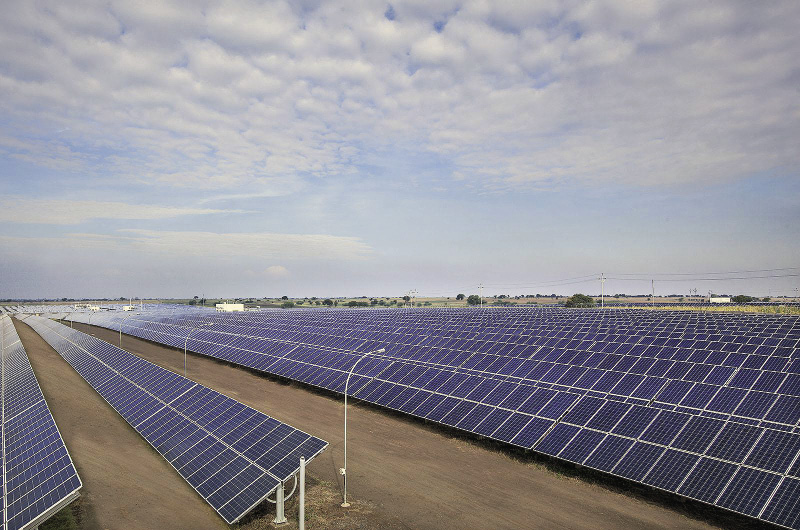India has set an ambitious target of integrating 175 GW of renewable energy capacity onto its grid by 2022, but has met with hiccups along the way. Achieving the milestone came under scrutiny starting in 2018, when an introduction of tariff caps and import duties on PV modules and cells added up to increase the cost of solar power generation. This is when developer Enrich Energy was looking to move forward with its 20 MW project for Shri Keshav Cement in Karnataka, India.
Faced with the challenge of meeting a tight deadline to have the project completed by November 2018, Enrich Energy chose TBEA as the inverter partner to meet its complex project requirements and schedules.
“That was the time when there was a fair bit of uncertainty as module prices were fluctuating and there were issues related to cell availability. So we had to move in quickly for the project as we had hardly 4.5 months to have it installed,” Vinayak Deshpande, general manager-supply chain management at Enrich Energy told pv magazine. “We chose TBEA because we felt it could deliver the project in time.”
According to Deshpande, with a wide range of modules and intelligent software technologies available, TBEA inverters have been able to continuously meet their project expectations and crunched installation timelines in the Indian market. With an aggregate capacity of 400 MW commissioned so far, Enrich Energy now has three projects with TBEA inverters – two in Maharashtra and one in Karnataka.
Aside from the Karnataka project, which specified eight central TBEA containerized inverters for each 2.5 MW array, Enrich Energy has moved forward with two additional projects in the Indian state of Maharashtra. Enrich Energy’s 3.75 MW plant in the Mandrup Solar Park in the district of Solapur for a pharmaceutical company, CleanScience, used TBEA’s TC3750KF inverters. The power generation from this plant will be consumed entirely by CleanScience. And now the developer is executing its third project in partnership with TBEA, for independent power producer AMP Energy. The latest 20 MW Enrich Energy project is the first installation to fall under India’s group captive scheme, wherein solar projects are set up for the collective use of multiple industrial or commercial consumers who have 26% equity in the project and must consume 51% of the power produced. The installation uses four 1,500 V outdoor inverters for each of the two 10 MW arrays.
Perfect match
Modules produce different power outputs with different inverters. To obtain higher yields in power generation, the I-V curve input of an inverter must match with the modules’ I-V curve for generation. Enrich Energy follows a rigorous process to find the perfect match.
“We keep a watch on what is happening in the market and what technology is being adopted by other players, not just locally but also globally. We operate with a restricted vendor list, which includes four to five top vendors,” explained Deshpande. “We run analysis on the different combinations of chosen inverters and modules to discover whether a certain inverter provides a pretty stable output irrespective of which module manufacturer we source from.”
The next step is analyzing costs for the various vendor combinations. “TBEA inverters give a consistent amount of generation for different types of modules. That’s one of the reasons why we have preferred TBEA inverters,” stated Deshpande.
“Our experience with TBEA has had them delivering beyond our expectations. For example, in the Karnataka project, our design predicted that we could generate 6,800-6,900 kWh at peak time under the best ambient temperature and irradiance conditions. To our pleasant surprise, the generation is 7,400-7,500 kWh/day per MW – which is 15% higher than what we get on good days,” he added.
Special features
Deshpande says that in addition to meeting Enrich Energy’s condensed timelines and output needs, TBEA is providing a host of special features in its inverters.
“TBEA inverters offer automatic power factor correction limit of up to 30 kVA/MW, which is higher than other inverters,” says Vinayak. “Power factor delivery of almost 1, guaranteed uptime of 99% for central inverters and 99.5% for string inverters irrespective of project size, compliance to all IS and CE codes, software for power plant control, all types of solutions including outdoor and containerized, customization, and safety features including AC and DC isolation are the other features available.”
Additionally, there are eight to 10 built-in intelligence features, which are becoming more important than ever before in today’s increasingly digitalized smart energy environment. The smart features include soft start, Low Voltage Ride Through (LVRT) protection, power factor correction, intelligent load management capability, automated grid synchronization, and reactive power compensation.
Payback period
Enrich Energy is looking to save costs to bring down tariffs for winning their next bid. “If you buy an outdoor solution from TBEA, you get an IP 50/65 container, so you save on the control room cost directly,” said Deshpande. “Additionally, you can select a larger size of container wherein you can mount your fire alarm system and SCADA” for increased security and remote plant management.
Based on daily generation capacity, he estimates the payback period to be seven to eight years with Enrich Energy’s installations specifying quality modules, TBEA inverters, and good O&M practices.
Looking ahead
The partnership continues to shine between the two companies. At some point in the near future, Enrich Energy will start working with TBEA on a mass-scale solar PV project featuring string inverters. “Looking ahead, people will move to string inverters as these are preferred in terms of availability and reduced failures, whereas central inverters have their advantages in terms of cost,” explained Deshpande. “A smart developer will always look at the balance between cost, availability, and quality of power generation.”
This content is protected by copyright and may not be reused. If you want to cooperate with us and would like to reuse some of our content, please contact: editors@pv-magazine.com.
